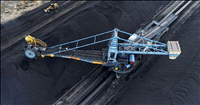Copper salts have found place in many industries, from pharmaceutics to agriculture, but they are rarely seen in petrochemistry and petroleum extraction. But not for long, it seems, now that Kazan Federal University scientists showed that copper stearate can be a great catalyst for in-situ combustion and even improve oil quality under certain conditions.
As the authors explain, most of the existing oil oxidation catalysts are synthesised from transition metals. But their one setback is that they are not soluble in oil and therefore not distributed in its volume.
Evidently, there is not much to expect from them as catalysts in that case. That's why the researchers are looking for other compounds with high solubility and tried copper stearate. Its effectiveness was tested through high-pressure differential scanning calorimetry (HP-DSC) and adiabatic reaction calorimetry (ARC).
The results were then compared to the already studied nickel stearate, iron stearate, and copper oxide. Copper stearate showed good results — it enhances oxidation, reduces activation energy, induction time, and combustion temperature, and increases coke burning efficiency. Its activity spectrum was also studied.
Lab Head Mikhail Varfolomeev comments, "In-situ combustion comprises three stages: low-temperature burning, cracking and pyrolysis, and high-temperature burning. As the tests have shown, copper oxide only works during the latter two stages and is thus a heterogeneous catalyst which requires high temperatures to be activated. Conversely, copper stearate proved to be an excellent low-temperature homogeneous catalyst."
Furthermore, copper stearate then dissipates into nanoparticles of copper oxide, which activates later in the reaction. The catalytic effect is many times more pronounced than during the use of just copper oxide. The researchers link this phenomenon to the fact that copper stearate is oil-soluble and thus serves as a means of transport for copper oxide.
"Based on this experiment, we can firmly say that our catalyst works for both low-temperature and high-temperature oxidation," says paper co-author Yuan Chengdong. "It may also affect cracking and pyrolysis, but we cannot definitely determine that with our methods."
Thus, copper stearate demonstrated its capacity to be a trigger for in-situ combustion. It also is rather cheap and easily accessible, so, coupled with its catalytic effect, this compound promises to become one of the best options for in-situ combustion and underground refining.













.jpg)






.jpg)









